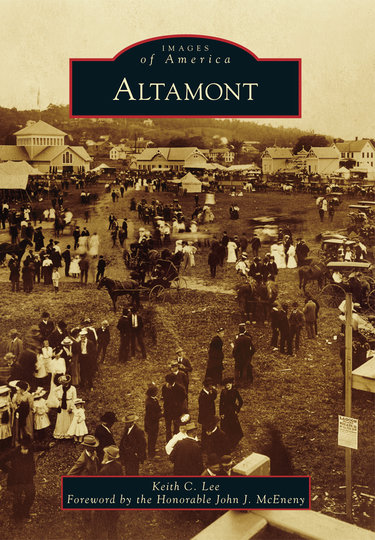Compact history, in photos, informs and delights
ALTAMONT — Altamont’s story from its near-beginning through the mid-20th Century has now been recorded in pictorial fashion and preserved in the book Images of America: Altamont, written by local resident Keith C. Lee, with help by members of the Village of Altamont Archives and Museum.
As the village prepares to kick off another historic fair season — with exhibitors and vendors flooding into Altamont for the upcoming week — Lee will hold a book sale and signing on Sunday, Aug. 10, from 3 to 5 p.m. in the Community Room at Village Hall.
Asked to talk about his book, Lee’s ebullient laughter prefaced his comment, “Well, it’s not very big.”
With good humor, he continued, “I’m so pleased to have it coming to fruition. I think it’s going to be well received. You’ve covered a little bit of the history of the village. It’s important that everyone can see just how important the history of the village is.”
The Altamont Fair has played a large part in the development of the village, and Lee and his team covered it well in Images of America: Altamont.
“The Flower [and Fine Arts] Building is iconic — almost as iconic to Altamont as the [park] gazebo is,” Lee said. The building, erected in 1896, is now listed in the New York and the National Registers of Historic Places, Lee wrote in his book.
“Almost every image of the fair from that date has the Flower Building. It’s such a beautiful, classic old building,” he said. Of the six or seven pictures Lee submitted for the cover, the publisher, Arcadia, selected the fair photo, he said.
“We were pleased to see this,” he said. “The way they sepia-toned it, it all looks so great.”
The team
Lee credited the museum’s curator, Marijo Dougherty, for suggesting the project.
“She thought we should try to do this,” he said. They contacted the publisher, Arcadia Publishing, which is known for putting out photographic histories of municipalities.
“Working with the museum’s extraordinary volunteers on this project and seeing Keith’s research bring the collections into focus [by] telling the story of our village ‘under the Hellebergs’ in well-chosen words and excellent images, was a very enriching experience,” Dougherty wrote via e-mail.
Lee praised the volunteer team that assisted him on the project, including Dougherty, Connie Rue, Laura Shore, and Ron Ginsburg.
“I began volunteering last winter when the project was already in full swing, so my contribution was much less than Marijo, Keith, Ron, and Connie, who sourced and scanned over 800 photos from which 300 were selected for the book,” said Shore in an e-mail.
“Each played an important role, whether scanning [and] retouching, building a database to keep it all straight, and then writing and research, with Marijo managing the publisher, editing Keith, and keeping it all on track,” she said. “For me, the best part of the project was getting to know this amazing group of people.”
Lee said that Ginsburg scanned the photos from the village collection, and also took a few photos of key landmarks for which no vintage picture could be found.
“He had fabulous equipment,” Lee said, praising Ginsburg’s skills. Lee also acknowledged the research done by Rue and Shore.
Lee began volunteering with the museum five years ago after retiring from the state’s Department of Motor Vehicles. Lee holds a bachelor’s degree in history from the State University of New York College at Oneonta.
Asked how he became the writer of Altamont’s history, he said, “Marijo thought that I could do it, and I said, ‘OK, I’ll do it.’ ”
He used his history background and research skills while writing the book.
“It’s an interesting place,” he said of Altamont, “the way buildings have been changed and repurposed. It’s interesting to watch the progression.”
The history
Arcadia’s parameter for the era to be covered in the research was from 1850 to 1950, or the late 19th Century and the early 20th Century, Lee said.
“Altamont's history is entwined with the Dutch, German, and Irish heritage of those who settled this region,” said Altamont’s current mayor and Lee’s partner, James Gaughan. “The village is… excited to celebrate our cultural heritage.”
“Most of the [photos] were in the archives,” Lee said. “They were in boxes and they were in albums.” The team sorted the photos into groups paralleling the chapters that appear in the book: early history, transportation, schools, the fair, government, and Altamont’s history as a summer retreat for city dwellers.
“Once we found the images, it was a matter of telling a story,” Lee said. Each informational caption for photos was limited to between 50 and 70 words, he said; where he could use one caption for two photos, he could expand the caption to 140 words to place the photos in their proper settings.
“That can be very painful,” he said of paring down descriptions of pictures, “but we learned how to do it.”
The group researched ancestry databases to track down names of siblings featured in the photos, and used files from the New York State Museum and the Albany Institute of History and Art, he said.
“A big resource was The Enterprise,” Lee said, noting that columns from a century ago gave such personal detail about residents that they seemed to track people “when they sneezed.”
“Nothing of Altamont existed before 1864,” Lee said. “Our history is very compact.” He said that, after the railroad came through the area in 1863, settlers laid out the streets, filled in the swamps, and, in 20 years, built a village.
“It’s amazing how quickly they put it together,” Lee said. “After I got my brain around that, I wanted to know what happened next.”
In the book, Lee was able to include a photo of a two-story gazebo in what is now Orsini Park.
A man in Kinderhook (Columbia Co.) recently found photograph negatives, Lee said, and two of them were pictures of Altamont, including the “completely new, unseen image” of the gazebo.
Although the book had been sent in its entirety to Arcadia, the publisher allowed Lee to swap out another photo in favor of the gazebo picture at the last minute, he said.
“That’s the best part, when you get those surprises,” Lee said. “It’s great!”
“The fabric of this village is composed of the story of many people’s life experiences,” Dougherty wrote. “The story repeats itself throughout the founding of this country. Arcadia Publishing aptly named their series of books Images of America, and I think Altamont’s story is among the best.”
Mayor Gaughan said, “[We] hope that the book's dedication to research and preservation enriches the history for all of what is known about the founders of the village. It's a reminder to the current generations of the history and character of the people of Altamont.”
Exhibits featured in the book will be on display in the hallway gallery inside Village Hall during Lee’s book signing Sunday, he said. Hungerford Market is providing food, he said, and visitors will be served punches and other interesting drinks, he said.
“All proceeds from the sale of the book go to support the Altamont Archives & Museum,” Lee said. “There will be a small royalty from sales in bookstores such as The Book House or Barnes & Noble, but if the book is purchased at the book-signing or later at Village Hall, all the proceeds go the Archive.”
Lee expects the book signing to be an interesting day.
“There’ll be politicians everywhere,” he said. “There will be people, I hope, who want to see this book.”





